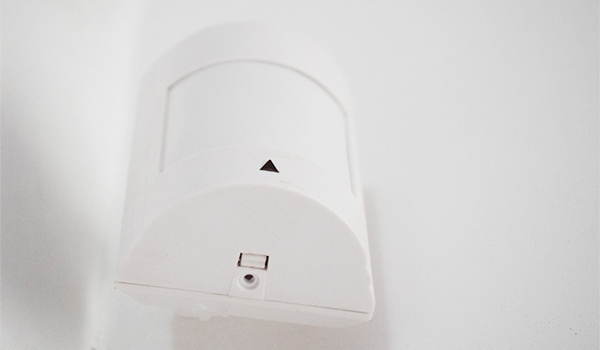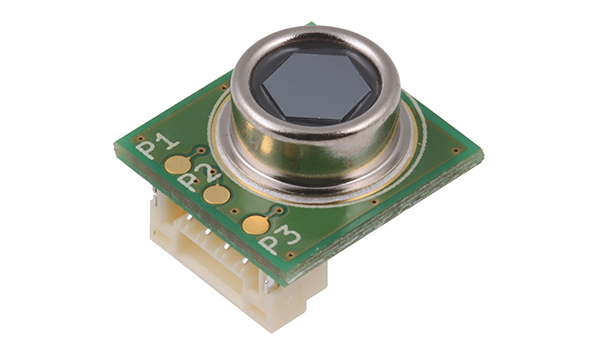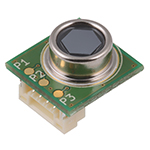Thermal IR sensors
Thermal IR sensors have a wide wavelength range and can be used at room temperature, so they do not require a cooling device, which enables a compact, lightweight design for products in which they are mounted.

An IR sensor, or infrared sensor, is a sensor that uses infrared light. IR sensors detect the heat (infrared radiation) emitted by people and objects for enabling operation of various devices. This section presents the features and application examples of IR sensors that make our daily lives more convenient.
IR sensors are sensors that receive infrared light and convert it into electrical signals. There are two types of IR sensors, each using a different operating principle: thermal sensors that detect the electrical properties changed by infrared heat, and quantum sensors that detect electrical phenomena caused by light energy.
Thermal IR sensors have a wide wavelength range and can be used at room temperature, so they do not require a cooling device, which enables a compact, lightweight design for products in which they are mounted.
Quantum IR sensors have high detection sensitivity and excellent response speed. However, a cooling device is required to take advantage of their high sensitivity.
IR sensors using MEMS can be made ultra-compact and are easy to mass-produce. Major applications include so-called white goods such as refrigerators and air conditioners, temperature monitoring equipment, and systems for monitoring abnormal temperatures.
Inexpensive thermistors are widely used as sensors that sense temperature. However, today, IR sensors using MEMS are replacing thermistors in a variety of devices because they are more responsive than thermistors and can detect using both contact and non-contact methods. In particular, MEMS can be miniaturized and easily mass-produced, so they are often used in white goods for the purpose of adding value in terms of safety and convenience.
IR sensors are being used all around us in our everyday lives. For example, in air conditioners, they detect heat emitted from people in the room, and in refrigerators, they detect uneven temperature of food in the cabinet for enabling efficient cooling. Recently, these sensors are being incorporated into non-contact thermometers, which can instantly measure a person’s body temperature by pressing a button near the person being measured. They are also used in abnormal temperature monitoring systems.

MinebeaMitsumi’s IR sensor is a thermopile sensor using MEMS technology. To perform non-contact measurement of the surface temperature of an object, this sensor uses the principle that a thermoelectromotive force is obtained that is proportional to the incident energy (heat) of the infrared radiation emitted by the object. The output is converted to a digital value inside the sensor and is output.
MinebeaMitsumi’s IR sensors have a noise equivalent temperature difference (NETD) of 0.06°C or less, which is one of the lowest in the industry, for enabling viewing of fine temperature differences. Furthermore, since the temperature value is directly output, it is easy to import into software applications. Also, the IR sensor has an integrated connector unit, eliminating the need for a separate dedicated sensor board and allowing a wider degree of freedom in installation.
| MMS701 | |
|---|---|
 |
|
| Supply voltage range (VDC) | 4.5 to 5.5 (5.0 typ.) |
| Object temperature range (°C) | −40 to 80 |
| Operating temperature range (°C) | −40 to 80 |
| Viewing angle (°) | 25 |
| Number of pixels | 1 (1 pixel) |
| Temperature resolution (NETD) (°C) | 0.06 |
| Temperature accuracy (°C) | ±1.5 max. at adjustment point |
| Power consumption (mA) | 3.5 typ. |
| Interface (output format) | I2C |
| Dimensions (mm) | 11.6 × 12.0 × 8.7* |
Including rear connectors
Adjustment points: (1) Tx = 5°C, Ta = 5°C (2) Tx = 25°C, Ta = 5°C (3) Tx = 25°C, Ta = 5°C Tx: Object temperature, Ta: Reference temperature
As with typical IR sensors, MinebeaMitsumi products are anticipated to be used in a wide variety of home appliances. In addition to refrigerators and air conditioners, they can be used to detect the surface temperature of clothes in clothes dryers to prevent uneven drying, and in facial care devices to detect skin temperature.